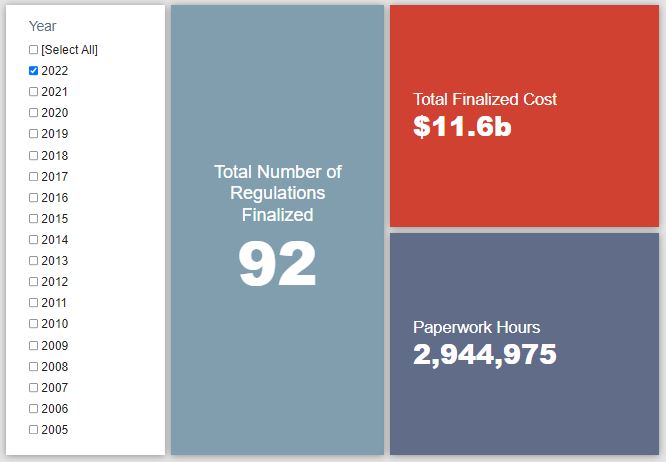Week in Regulation
May 16, 2022
Lightbulb Efficiency Rules Shine the Brightest
While it did not reach the dizzying heights of the preceding week, this past week did see some notable activity on the regulatory front. There were only nine rulemakings with some quantifiable economic impact, but costs still rose by the billions of dollars. A pair of rules from the Department of Energy (DOE) regarding energy efficiency standards for “General Service Lamps” (GSLs) provided the main highlights of the week. Across all rulemakings, agencies published $5.3 billion in total net costs and added 1.3 million annual paperwork burden hours.
REGULATORY TOPLINES
- Proposed Rules: 32
- Final Rules: 67
- 2022 Total Pages: 29,603
- 2022 Final Rule Costs: $11.6 billion
- 2022 Proposed Rule Costs: $74.3 billion
NOTABLE REGULATORY ACTIONS
The main actions of the week, DOE’s two rules on GSLs, essentially provide a two-pronged approach to addressing the energy efficiency standards for such products. The first rule reverses the Trump-era rulemaking on GSLs under the determination that the previous administration’s action violated the “backstop requirement” under the Energy Policy and Conservation Act, the legislation that grants DOE the authority to regulate energy efficiency standards for consumer products. Essentially, where the Trump-era DOE demurred on ratcheting up the standards on GSLs, the current administration has determined those standards do need to be strengthened. The second rule builds upon that even further by expanding the regulatory definition of GSLs and thus the pool of products potentially affected. In terms of economic impact, DOE estimates that the former brings $2.4 billion in “Consumer Incremental Product Costs,” while the latter brings $2.7 billion, for a grand total of $5.1 billion in increased costs.
TRACKING THE ADMINISTRATIONS
As we have already seen from executive orders and memos, the Biden Administration will surely provide plenty of contrasts with the Trump Administration on the regulatory front. And while there is a general expectation that the current administration will seek to broadly restore Obama-esque regulatory actions, there will also be areas where it charts its own course. Since the AAF RegRodeo data extend back to 2005, it is possible to provide weekly updates on how the top-level trends of President Biden’s regulatory record track with those of his two most recent predecessors. The following table provides the cumulative totals of final rules containing some quantified economic impact from each administration through this point in their respective terms.
![]()
The DOE rules discussed above provided the vast majority of the upward tick in the Biden Administration’s final rule cost total. Across the three covered administrations, however, the major movement came during the Obama years. Thanks primarily to the first round of Obama-era vehicle emission standards, the final rule cost total for that administration shot up by more than $51 billion, further closing the gap between it and Biden’s total to date. The Obama paperwork total measurably increased as well; the nearly 1.1 million hours of paperwork from an Affordable Care Act regulation was the main driver there.
THIS WEEK’S REGULATORY PICTURE
This week, the Biden Administration unveils a strategy to improve federal permitting.

On May 11, the White House released its “Permitting Action Plan,” which the administration said in an accompanying fact sheet will “strengthen and accelerate” federal permitting and environmental reviews through existing authorities.
The plan consists of five main elements. The first element is improving cross-agency coordination during the early stages of the process. The second is setting clearer timelines for approvals. The third is engaging in further outreach with affected communities. The fourth is improving technical assistance. The final element is providing adequate resources to agencies and improving environmental outcomes.
While the administration bills the plan as “transformative,” many of the details about how it will be implemented will be spelled out in future guidance and agency plans. It is also hardly unique for an administration to attempt reform permitting. Both the Trump and Obama Administrations, for example, engaged in similar efforts.
Many of the most meaningful components of the plan stem from the bipartisan infrastructure law enacted last fall. These include setting approximate deadlines for permitting decisions and improved coordination among agencies through the “One Federal Decision” process that puts one agency in charge of managing each review.
The Biden Administration, however, does incorporate its own priorities into the action plan. These include incorporating positive or negative climate impacts into decisions and ensuring that historically disadvantaged communities can meaningfully engage in the process. The plan also calls for agencies to include their projects on the federal permitting dashboard (pictured above).
Yet some of the plan appears to run counter to the goal of accelerating decisions. Its emphasis on using the environmental review process to improve environmental outcomes, for example, relies on a recently finalized rule implementing the National Environmental Policy Act (NEPA) that will necessarily increase the amount of time it takes for project to clear environmental review. In addition, a second NEPA rule expected to be proposed later this year will likely further increase review times.
TOTAL BURDENS
Since January 1, the federal government has published $85.9 billion in total net costs (with $11.6 billion in new costs from finalized rules) and 48.4 million hours of net annual paperwork burden increases (with 2.9 million hours in increases from final rules).












